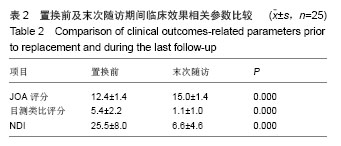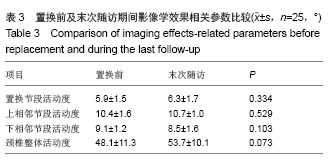| [1]Heller J, Sasso RC, Papadopoulos SM, et al.Comparison of BRYAN cervical disc arthroplasty with anterior cervical decompression and fusion: clinical and radiographic results of a randomized, controlled, clinical trial.Spine (Phila Pa 1976). 2009;34(2):101-107.
[2]McAfee PC,Cunningham BW, Devine J, et al.Classification of heterotopic ossification(HO)in artificial disk replacement. J Spinal Disord Tech. 2003;16(4):384-389.
[3]Peng CW, Yue WM, Basit A, et al.Intermediate Results of the Prestige LP Cervical Disc Replacement:Clinical and Radiological Analysis With Minimum Two-Year Follow-up. Spine-(Phila-Pa-1976). 2011; 36(2): E105-111.
[4]Mummanene PV, Burkus JK, Haid RW, et al. Clinical and radiographic analysis of cervical disc arthroplasty compared with allograft fusion: a randomized controlled clinical trial. J Neurosurg Spine. 2007;6(3):198-209.
[5]Fourney DR, Skelly AC, DeVine JG.Treatment of cervical adjacent segment pathology: a systematic review. Spine ( Phila Pa 1976). 2012;37(22 Suppl):S113-122.
[6]Ponnappan RK, Hilibrand AS. Adjacent segment disease of the cervical spine: fact or fiction. Curr Orthop Proc. 2008; 19(4):420-424.
[7]Helgeson MD,Bevevino AJ,Hilibrand AS.Update on the evidence for adjacent segment degeneration and disease. Spine J. 2013;13(3):342-351.
[8]Matsumoto M, Okada E, Ichhara D, et al. Anterior cervical decompression and fusion accelerates adjacent segment degeneration: comparison with asymptomatic volunteers in a ten-year magnetic resonance imaging follow-up study. Spine (Phila Pa 1976). 2010;35(1):36-43.
[9]Cason GW, Herkowitz HN.Cervical intervertebral disc replacement. J Bone Joint Surg Am. 2013;95(3):279-285.
[10]Beaurain J, Bernard P, Dufour T, et al. Intermediate clinical and radiological results of cervical TDR (Mobi-C) with up to 2 years of follow-up. Eur Spine J. 2009;18(6):841-850.
[11]Jan G, Johan VL,Frank VC, et al.A clinical analysis of 4- and 6-year follow-up results after cervical disc replacement surgery using the Bryan Cervical Disc Prosthesis.J Neurosurg Spine. 2010;12(3):261-269.
[12]Tan SH,Teo EC,Chua HC,et al.Quantitative three-dimensional anatomy of cervical, thoracic and lumbar vertebrae of Chinese Singaporeans. Eur Spine J.2004;13(2):137-146.
[13]Kim MK,Kwak DS,Park CK,et al.Quantitative anatomy of the endplate of the middle and lower cervical vertebrae in Koreans.Spine (Phila Pa 1976). 2007;32(14):E376-381.
[14]王岩.对颈椎人工椎间盘置换术的远期疗效需进一步评估[J].中国脊柱脊髓杂,2012,22(10):865-866.
[15]蓝旭,许建中,刘雪梅,等.Bryan人工颈椎间盘置换术后疗效评价及并发症分析[J].中国骨伤,2013,26(3):182-185.
[16]Suchomel P, Jurak L, Banes V 3rd, et al. Clinical results and development of heterotopic ossification in total cervical disc replacement during a 4-year follow-up.Eur Spine J. 2010 19(2):307-315.
[17]Yi S, Kim KN, Yang MS, et al.Difference in occurrence of heterotopic ossification according to prosthesis type in the cervical artificial disc replacement.Spine(Phila Pa 1976). 2010;35(16):1556-1561.
[18]Yi S, Shin DA, Kim KN, et al.The predisposing factors for the heterotopic ossification after cervical artificial disc replacement. Spine J. 2013;13(9):1048-1054.
[19]Barna M, Kryl J. ProDisc-C Total Disc Replacement.A Four-Year Prospective Monocentric Study. Acta Chir Orthop Traumatol Cech. 2012; 79(6):512-519.
[20]Du J, Li M, Liu H, et al. Early follow up outcomes after treatment of degenerative disc disease with the discover cervical disc prosthesis.Spine J. 2011;11(4):281-289.
[21]Huppert J, Beaurain J, Steib JP, et al. Comparison between single- and multi-level patients: clinical and radiological outcomes 2 years after cervical disc replacement. Eur Spine J. 2011;20(9):1417-1426. |



.jpg)
.jpg) 体的稳定性。
体的稳定性。